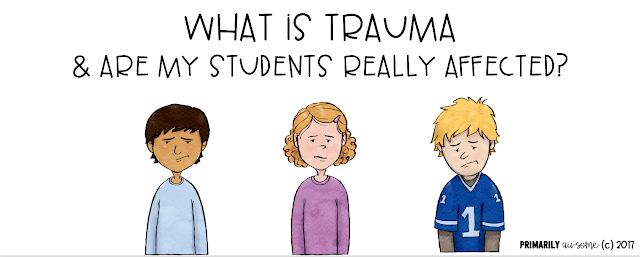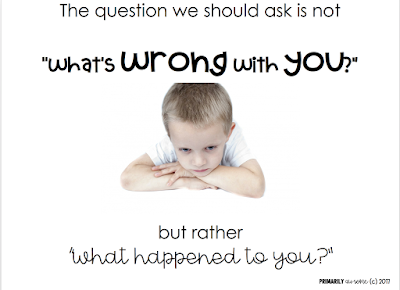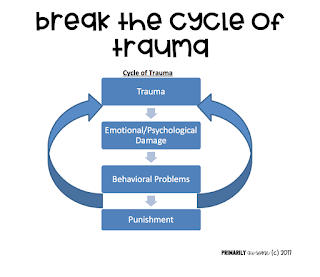I honestly never thought much about how trauma impacts my student’s learning. Sure, I knew that certain events in my student’s lives impacted them, but I never truly understood to the degree that they do impact student learning. I knew that little Eric may have it rough at home. And Caroline spent the weekend with her mom so her day will be rough today. But what trauma did they face? What effect will that trauma have on their ability to learn? I never thought of these things.
Trauma is a response to a negative external event or series of events which surpasses the child’s ordinary coping skills. It comes in many forms and includes experiences such as maltreatment, witnessing violence, or the loss of a loved one. Traumatic experiences can impact brain development and behavior inside and outside of the classroom. It is estimated that one half to two-thirds of children experience trauma. The trauma doesn’t have to be directed at the child and it doesn’t have to be violent in nature. The child could witness an event, be threatened, become injured, or even experience losing a loved one. Trauma can result in a lower GPA, higher rate of school absences, increased risk for drop-out, more suspensions and expulsions, and decreased reading ability.
Single exposure to traumatic events may cause jumpiness, intrusive thoughts, interrupted sleep and nightmares, anger and moodiness, and/or social withdrawal—any of which can interfere with concentration and memory.
Chronic exposure to traumatic events, especially during a child’s early years, can: adversely affect attention, memory, and cognition; reduce a child’s ability to focus, organize, and process information; interfere with effective problem solving and/or planning; and result in overwhelming feelings of frustration and anxiety.
- Physical symptoms like headaches and stomachaches
- Poor control of emotions
- Inconsistent academic performance
- Unpredictable and/or impulsive behavior
- Thinking others are violating their personal space, i.e., “What are you looking at?”
- Blowing up when being corrected or told what to do by an authority figure
- Fighting when criticized or teased by others
As educators what can we do?
We can work on enacting change within our schools. You may not know it but trauma informed approaches are already at work within medical professions and judicial systems all over the country and even the world. The heart of these approaches is a belief that students’ actions are a direct result of their experiences.
The question we should ask is not “what’s wrong with you,” but rather “what happened to you?” Sensitivity to students’ past and current experiences with trauma we can work to break the cycle of trauma, prevent re-traumatization, and engage a child in learning and finding success in school.
So what are some easy and practical ways you can practice trauma informed interventions in your classroom?
- Give children choices. Often traumatic events involve loss of control and/or chaos, so you can help children feel safe by providing them with some choices or control when appropriate.
- Increase the level of support and encouragement given to the traumatized child.
- Set clear, firm limits for inappropriate behavior and develop logical—rather than punitive— consequences.
- Recognize that behavioral problems may be transient and related to trauma. Remember that even the most disruptive behaviors can be driven by trauma-related anxiety.
- Provide a safe place for the child to talk about what happened. Set aside a designated time and place for sharing to help the child know it is okay to talk about what happened.
- Give simple and realistic answers to the child’s questions about traumatic events.
- Clarify distortions and misconceptions.
- If it isn’t an appropriate time, be sure to give the child a time and place to talk and ask questions.
- Be sensitive to the cues in the environment that may cause a reaction in the traumatized child. For example, victims of natural storm-related disasters might react very badly to threatening weather or storm warnings.
- Children may increase problem behaviors near an anniversary of a traumatic event.
- Anticipate difficult times and provide additional support. Many kinds of situations may be reminders.
- If you are able to identify reminders, you can help by preparing the child for the situation. For instance, for the child who doesn’t like being alone, provide a partner to accompany him or her to the restroom.
- Warn children if you will be doing something out of the ordinary, such as turning off the lights or making a sudden loud noise.
- Be aware of other children’s reactions to the traumatized child and to the information they share. Protect the traumatized child from peers’ curiosity and protect classmates from the details of a child’s trauma.
- Understand that children cope by re-enacting trauma through play or through their interactions with others. Resist their efforts to draw you into a negative repetition of the trauma. For instance, some children will provoke teachers in order to replay abusive situations at home.
- Although not all children have religious beliefs, be attentive if the child experiences severe feelings of anger, guilt, shame, or punishment attributed to a higher power. Do not engage in theological discussion. Rather, refer the child to appropriate support.
What do you do in your own classroom to support your students who have been through a trauma?
I’d love to know!




















Leave a Reply